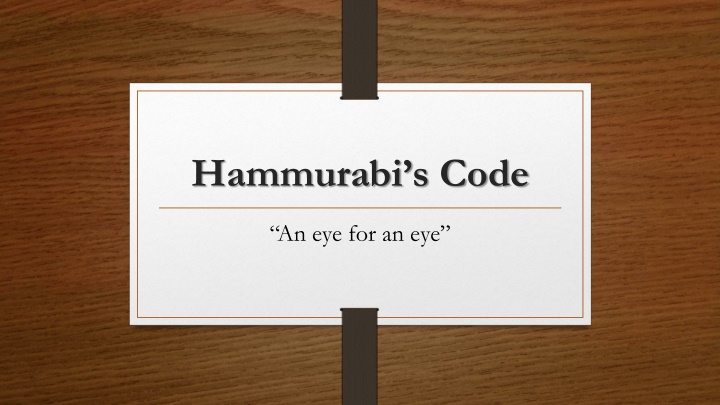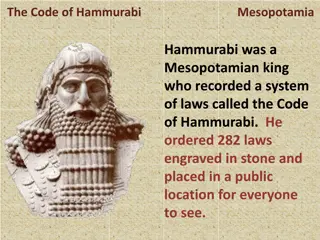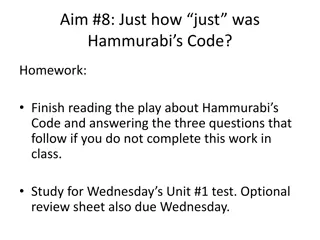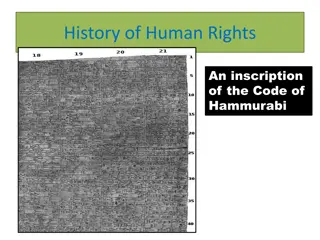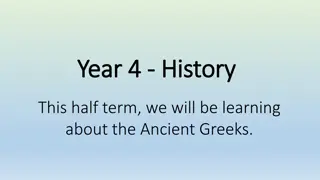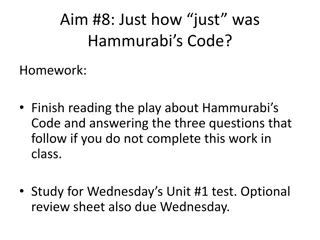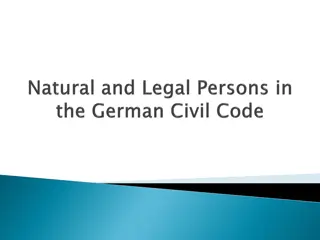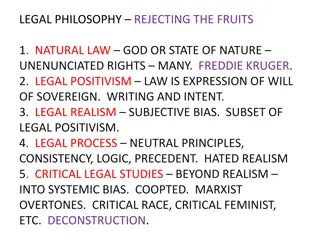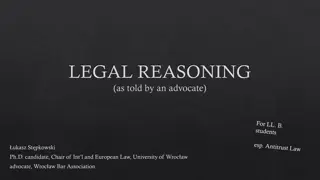Hammurabi's Code: Ancient Legal System
One of the earliest and most complete ancient legal codes was proclaimed by the Babylonian king Hammurabi, compiling 282 laws and standards to ensure justice. This code stipulated rules, set fines, and punishments to maintain order in Hammurabi's expanding empire. Discover the significance and implications of Hammurabi's Code, including examples of laws and its goal of establishing justice and fairness in Mesopotamia.
Download Presentation

Please find below an Image/Link to download the presentation.
The content on the website is provided AS IS for your information and personal use only. It may not be sold, licensed, or shared on other websites without obtaining consent from the author.If you encounter any issues during the download, it is possible that the publisher has removed the file from their server.
You are allowed to download the files provided on this website for personal or commercial use, subject to the condition that they are used lawfully. All files are the property of their respective owners.
The content on the website is provided AS IS for your information and personal use only. It may not be sold, licensed, or shared on other websites without obtaining consent from the author.
E N D
Presentation Transcript
Hammurabis Code An eye for an eye
What was it? One of the earliest and most complete ancient legal codes was proclaimed by the Babylonian king Hammurabi, who reigned from 1792 to 1750 B.C. His code, a collection of 282 laws and standards, stipulated rules and set fines and punishments to meet the requirements of justice. It was rediscovered in 1901 by a French archaeological team in present-day Iran.
Who was Hammurabi? Hammurabi was the sixth king in the Babylonian dynasty, which ruled in central Mesopotamia (present- day Iraq) from c.1894 to 1595 B.C. In the 30th year of his reign Hammurabi began to expand his kingdom up and down the Euphrates, until all of Mesopotamia under his sway.
The Need for a Code As he conquered other city-states and his empire grew, he saw the need to unify the various groups he controlled. Hammurabi understood that to achieve this goal, he needed one universal set of laws for all of the diverse peoples he conquered. Legal experts were sent throughout his kingdom to gather existing laws. These laws were reviewed and some were changed or eliminated before compiling his final list of 282 laws.
Hammurabis Goal The prologue or introduction to the list of laws is very enlightening. Here, Hammurabi states that he wants "to make justice visible in the land, to destroy the wicked person and the evil-doer, that the strong might not injure the weak."
Examples of some Laws If you accidentally break someone s arm Then your arm will be broken If a slave talks back to his master Then, his ear shall be cut off If a you hit your father Then, your hand will be cut off If you break into another s house Then, you shall be put to death
A Few More Examples If a man knock out the teeth of his equal, his teeth shall be knocked out. If a slave says to his master: "You are not my master," if they convict him, his master shall cut off his ear. If a physician make a large incision with the operating knife, and kill him, his hands shall be cut off. If a builder has built a house for a man, and has not made his work sound, and the house he built has fallen, and caused the death of its owner, that builder shall be put to death. If it is the owner's son that is killed, the builder's son shall be put to death.
Was it Fair? A number of the laws refer to jumping in the Euphrates River as a method of demonstrating one's guilt or innocence. If the accused returned to shore safely, they were deemed innocent; if they drowned, they were guilty. This practice follows the Babylonians's belief that their fates were controlled by their gods
Was it Fair? From the code, it is evident that the Babylonians did not believe all people were equal. The code treated slaves, commoners, and nobles differently
Examples of Social Class Differences If a man knock out the teeth of his equal, his teeth shall be knocked out, committing the same crime against a member of a lower class was punished with only a fine. If a man killed a pregnant maid-servant, he was punished with a monetary fine, but if he killed a free-born pregnant woman, his own daughter would be killed as retribution.
Your Turn Now it s your turn to create your own set of laws or code . Using the style of Hammurabi s Code as an example, create your own code for school. Try to come up with at least 10 laws and consequences if the laws are not followed.
